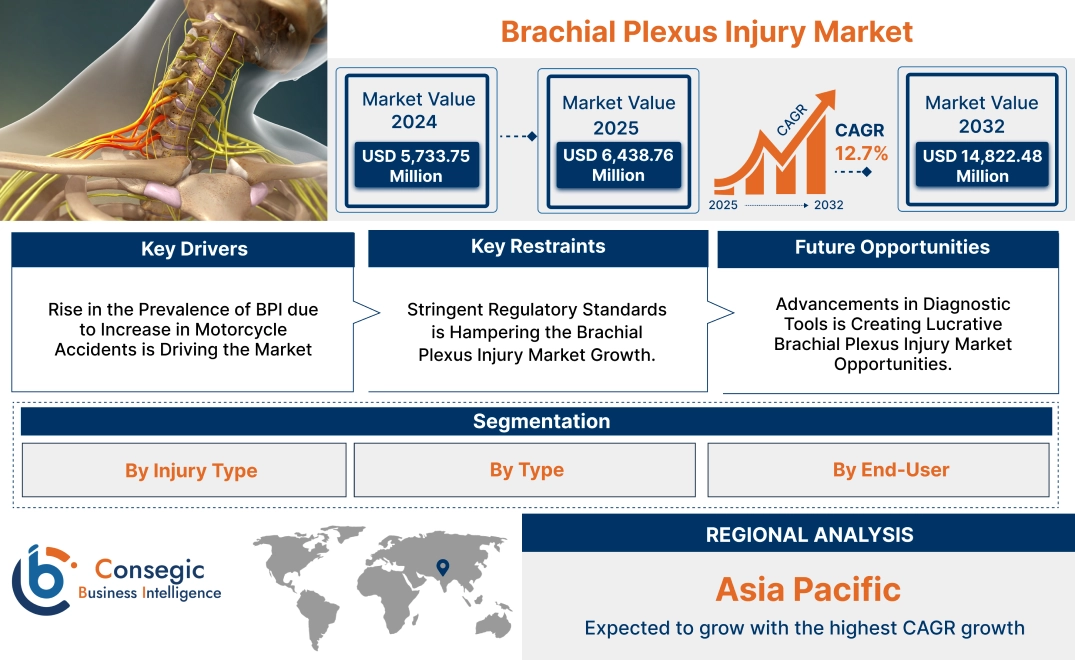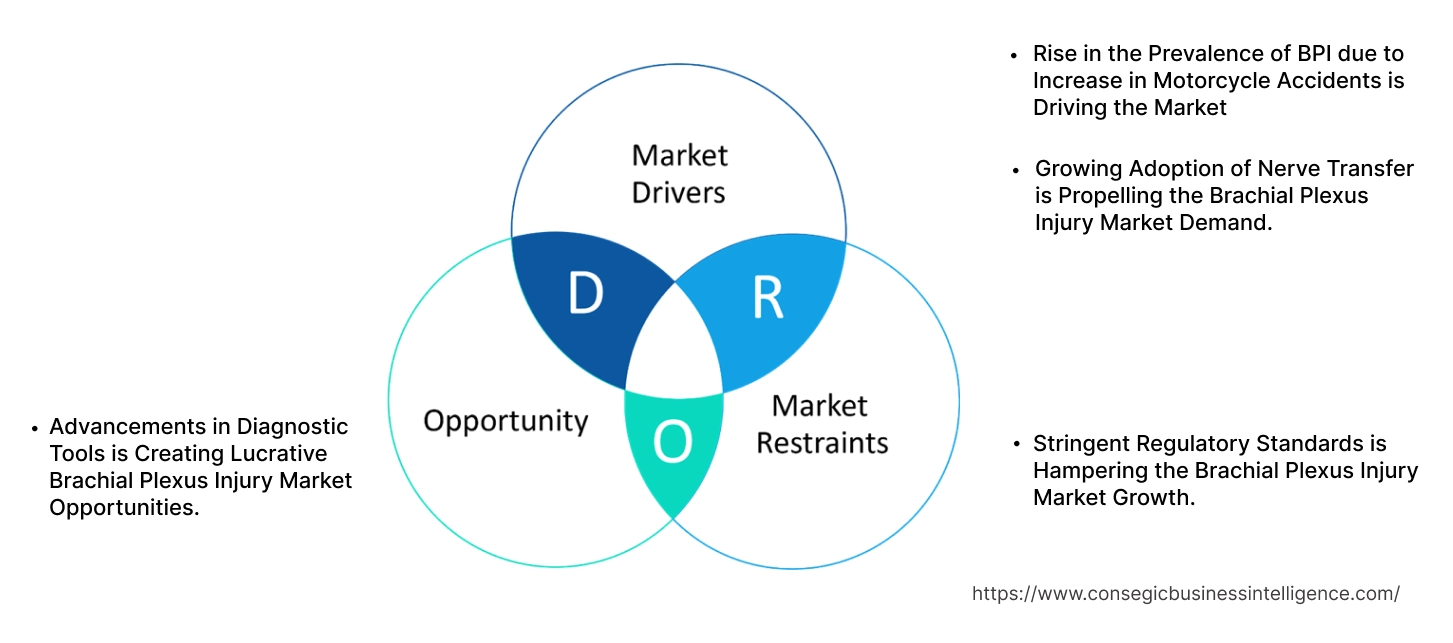- Summary
- Table Of Content
- Methodology
Brachial Plexus Injury Market Size:
Brachial Plexus Injury Market size is growing with a CAGR of 12.7% during the forecast period (2025-2032), and the market is projected to be valued at USD 14,822.48 Million by 2032 from USD 5,733.75 Million in 2024. Additionally, the market value for 2025 is attributed to USD 6,438.76 Million.
Brachial Plexus Injury Market Scope & Overview:
Brachial plexus injury (BPI) happens when there is trauma caused to the nerves. These nerves are responsible for controlling the movement and sensation in shoulder and arm. Trauma is caused when the nerves get stretched, torn, or compressed. The cause of trauma includes vehicle accidents, injury because of sports. Newborns also suffer from injury during difficult deliveries where forceful pulling is used. The other causes include complications from surgery, tumour that press on nerves, and inflammatory conditions amongst others.
The type of injury includes avulsion, rupture, neuroma, and neurapraxia. The type of diagnosis for this injury is done by tests such as x-rays, electromyography, MRI, CT-myelography, and others. The treatment includes surgical and non-surgical. The End-user are mainly hospitals, specialty clinics, ambulatory surgical centers, rehabilitation centers, others.
Key Drivers:
Rise in the Prevalence of BPI due to Increase in Motorcycle Accidents is Driving the Market
Motorcycles are the primary transportation method in various countries. There is a rise in the number of accidents because of motorcycles. This is one of the reasons for the rise in cases of brachial injury.
For instance,
- According to the data published in the National Library of Medicine, in July 2021, Brachial plexus injury occurred secondary to motorcycle accidents. This occurred in 72% of the cases, which is greater than the previous year.
Thus, the rise in the number of motorcycle accidents causes a rise in the prevalence of injury. This rise is driving the brachial plexus injury market growth.
Growing Adoption of Nerve Transfer is Propelling the Brachial Plexus Injury Market Demand.
Nerve transfer provides a more effective and faster way to restore movement and function. This is beneficial for patients with severe damage to their nerves. In this procedure a healthy nerve is used. This nerve is redirected to take the role of the damaged nerve. This helps patients regain mobility in the arm, hand or shoulder.
For instance,
- The data published in the National Library of Medicine, in 2024, states that postoperative results of nerve transfer show functional recovery. Complete strength and mobility are achieved in 64% of patients.
Hence, there is a rise in adoption of nerve transfer because of restorative properties. This is influencing the brachial plexus injury market expansion.
Key Restraints:
Stringent Regulatory Standards is Hampering the Brachial Plexus Injury Market Growth.
Stringent regulatory standards imposed by government bodies worldwide cause hurdles in the market. These regulations, designed to protect the environment and public health. This leads to increase production costs and slow down product development. Regulation slows down the adoption and approval of new treatment. The microsurgical techniques require experimental approaches. These approaches must meet safety requirements.
Regulatory bodies such as Food and Drug Administration (FDA), and European Medicines Agency (EMA) among other regulatory bodies impose long process for approvals. They are important for medical devices new methods of surgeries, regeneration of nerves, and others. Additionally, evolving federal regulations speed up the agreement and operating costs. Thus, the impact of these stringent regulations on the brachial plexus injury market expansion is complex.
Future Opportunities :
Advancements in Diagnostic Tools is Creating Lucrative Brachial Plexus Injury Market Opportunities.
The advancements in diagnostic tools allow for early detection. It provides more accurate diagnosis of the damage to the nerve. Innovations in MRI, and nerve conduction studies has made it easy for doctor to pinpoint the exact location of injury. It also helps doctors to identify complex surgeries. They provide high resolution images. The inclusion of AI in these tools offer advanced imaging solutions
For instance,
- In 2024, Siemens Healthineers developed Magnetom Flow a novel MRI platform. The MRI machine provides enhanced comfort to the patients. They also offer a well-developed quality of the image. The image reconstruction is supported by AI. This is beneficial for diagnosis of BPI.
Thus, the advancements in the tools use for diagnostics creates lucrative brachial plexus injury market opportunities in the coming years.
Brachial Plexus Injury Market Segmental Analysis :
By Injury Type:
Based on injury type, the market is categorized into avulsion, rupture, neuroma, and neurapraxia
Trends in the Injury Type:
- The rise in the accidents caused because of sports leads to avulsion injury.
The avulsion segment accounted for the largest market share in 2024 and is expected to grow at the fastest CAGR over the forecast period.
- Avulsion is one of the serious types of nerve damage.
- It is caused because of high impact trauma.
- It occurs when the nerve is completely torn from the spinal cord.
- The primary causes include violent falls, injury caused because of sports, and motorcycle accidents
- This type of injury causes complete loss of function and sensation in the affected area.
- The rise in traffic accidents is the major cause of avulsion.
- For instance, the National Library of Medicine, in 2023, states that most of the avulsions are caused by traffic accidents. Approximately 70% patients sustain avulsion in the plexus.
- Thus, the rise in the avulsion caused because of accidents drives the segment.
By Type:
Based on type, the market is categorized into diagnosis and treatment.
Trends in Type:
- Rise in the trend for early detection of condition influences the demand of advanced tools for diagnostics.
- The rise in physical therapies to promote nerve healing is influencing the segment
The treatment segment accounted for the largest market share in the year 2024 and is expected to grow at the fastest CAGR over the forecast period.
The treatment segment is further classified in surgical and non-surgical.
- The treatment of BPI consists of both surgical and non-surgical options. This depends on the severity of the injury.
- Surgical procedures are performed for severe injuries such as rupture and avulsion.
- They include procedures such as nerve grafting. In this process, health nerves are used to fill gaps.
- Nerve transfer is a widely used method where nerves from less critical areas are used. The nerve is redirected to the affected area.
- Doctors also perform transfer of muscle and tendon surgery to improve movement.
- Non-surgical treatment includes physical and occupational therapy to help patients adjust to activities.
- Various clinics offer these therapies for pain management.
- For instance, For instance, in October 2024, Pain Free Lives, a leading provider of innovative pain relief therapies, opened a specialized clinic in Brooklyn. The clinics offer novel pain management techniques. They include advanced physical therapy modalities, and expert guidance from experienced pain specialists.
- Pain relief medication is also used to manage pain caused by injury.
- Thus, these factors are influencing segment growth at present and in coming years.
By End User:
Based on end users, the market is categorized into hospitals, specialty clinics, ambulatory surgical centers, rehabilitation centers, and others
Trends in the End User:
- Increasing availability of multidisciplinary approaches combined physical therapy and pharmacological solutions.
- High focus on physically active individuals with customized rehabilitation programs.
The hospital segment accounted for the largest brachial plexus injury market share of 48.91% in the year 2024.
- Hospitals serve as a primary healthcare facility where nerve injury patients are treated.
- When someone suffers from a traumatic event such as accidents, they are rushed to hospitals.
- Hospital has a specialized team of surgeons, neurologists, and other doctors to manage the condition.
- They also provide services such as advanced diagnostics tools, surgical options, and post-surgical care.
- As the treatment for brachial plexus injury is a long-term process, hospitals offer a good care plan.
- New hospitals are launched that are specifically designed to provide treatment for brachial plexus injuries.
- For instance, in 2024, Sakra World Hospital introduced a novel facility for brachial plexus and peripheral nerve treatments in India. The facility consists of novel technologies for diagnosis and treatment.
- Thus, as per the market analysis, these factors are influencing the brachial plexus injury market trends.
The ambulatory surgical centers segment is expected to grow at the fastest CAGR over the forecast period.
- Ambulatory surgical centers (ASC) have the ability to provide effective and specialized care.
- They provide surgical procedures in less resource-intensive environments.
- This allows for quicker recovery and cost-effective solutions for the patient.
- Patients with brachial plexus injury are benefitted by this setting as it offers minimally invasive surgery, and nerve grafting among others.
- Additionally, these facilities consist of advanced technology and specialized equipment.
- This helps them to deliver high-quality care and maintain a personalized approach.
- Thus, based on the brachial plexus injury market analysis, the aforementioned factors contribute to ambulatory surgical centers as prominent end-users. This is further driving the segment growth.
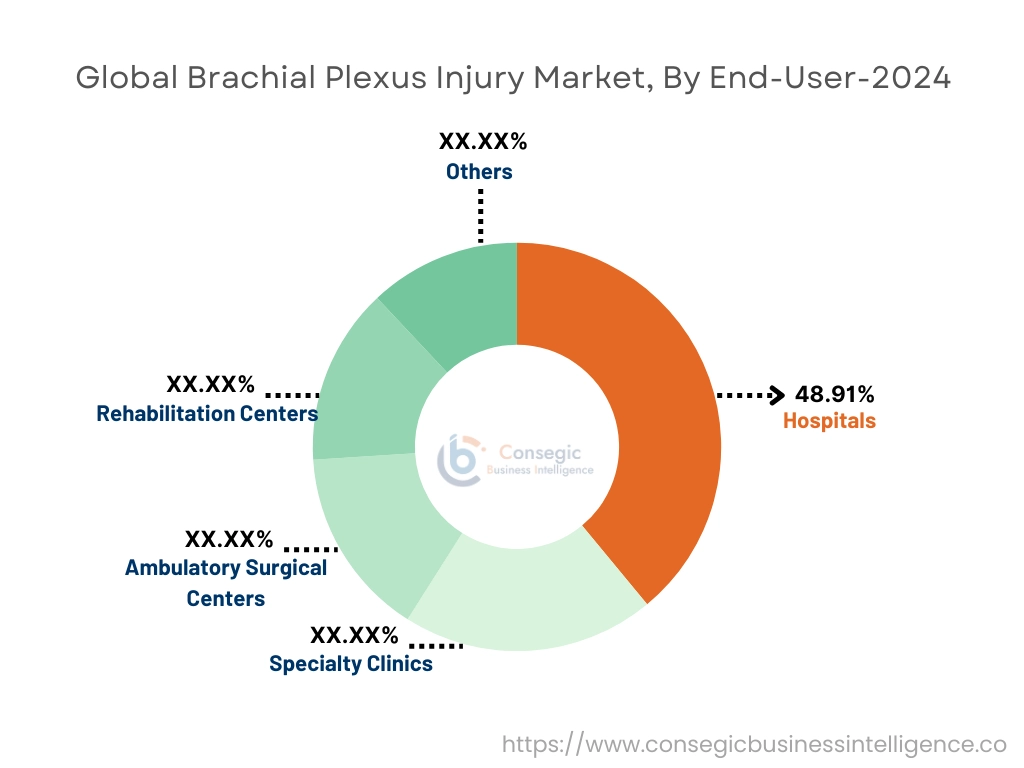
Regional Analysis:
The regional segment includes North America, Europe, Asia Pacific, the Middle East and Africa, and Latin America.
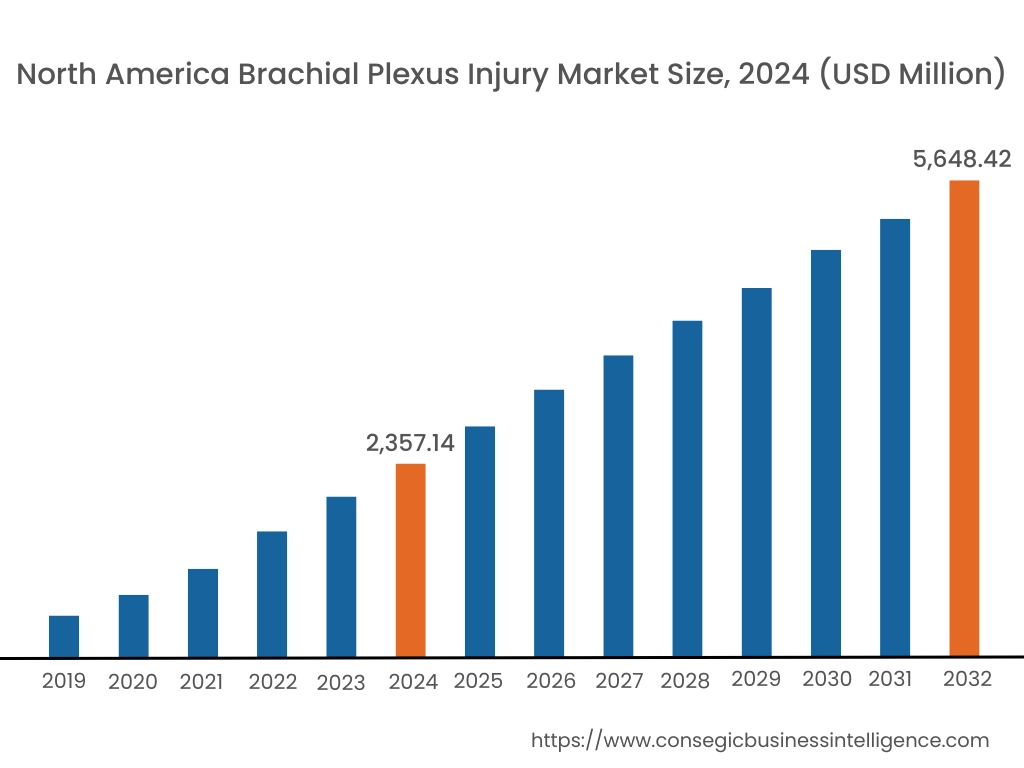
In 2024, North America accounted for the highest market share at 41.11% and was valued at USD 2,357.14 Million and is expected to reach USD 5,648.42 Million in 2032. In North America, U.S. accounted for the highest market share of 71.82% during the base year of 2024. North America has a progressed healthcare infrastructure. They provide focused care for brachial plexus injuries. The treatment consists of nerve transfer surgeries, and regeneration treatment. Countries such as U.S. and Canada offer better treatment services such as physical therapy. The presence of various rehabilitation clinics provides good treatment options.
For instance,
- In October 2024, The Columbia VA Health Care System announce the opening of its rehabilitation clinic. The clinics provide proper treatment options with novel equipment. They provide physical and occupational therapy. This is beneficial for patients with brachial plexus injury.
Thus, based on the brachial plexus injury market analysis, the aforementioned factors are driving the market in this region.
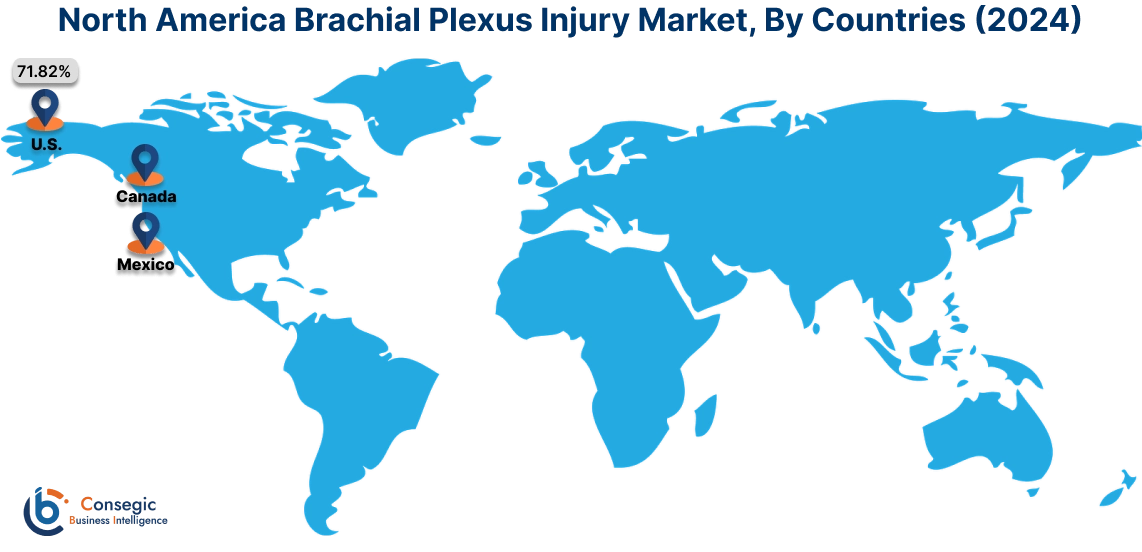
Asia Pacific is experiencing the fastest growth with a CAGR of 14.7% over the forecast period. The brachial plexus injury market trend is because of the availability of conventional and surgical procedures. Doctors in this region provide good surgical approaches for the treatment of injuries. The region has well-trained doctors to perform surgeries. The countries like China, Japan, and India have a developing healthcare industry. They offer minimally invasive procedures for better treatment. Thus, the availability of developed surgical procedures is influencing the market trends in this region.
Europe makes a significant contribution to market analysis. The European healthcare industry is mature. This creates a constant need for advanced solutions. The region consists of many prominent manufacturers. They focus on the growth of novel diagnostics and treatment options. It leads to the rise in research and development activities. Thus, based on market analysis, the rise in the research and development activities and demand of novel devices is influencing the market trends.
The Middle East and Africa (MEA) regions are observing brachial plexus injury market demand. This is because of the healthcare industry. There is a development in non-surgical methods of treatment. This is because of several factors. The rise in awareness about the post-operative problems is the primary factor. Rise in the population participating in sports and fitness activities leads to the prevalence of brachial plexus condition. This requires the development of treatment options. These factors are driving industry demand.
Latin America is an emerging region in the Brachial Plexus Injury market share. The region has significant potential for innovation. There is a rise in the number of accidents. This causes injuries such as brachial plexus. The rise in the number of injuries needs accurate diagnosis and treatment options. Development of advanced imaging technologies offer more proper diagnosis for the condition. Thus, as per the market analysis, these factors have led to market growth in this region.
Top Key Players and Market Share Insights:
The global Brachial Plexus Injury market is highly competitive with major players providing precise products to the national and international markets. Key players are adopting several strategies in research and development (R&D) and product innovation to hold a strong position in the global Brachial Plexus Injury market. Key players in the Market include-
- Merck KGaA (Germany)
- Novartis (Switzerland)
- Hoffmann-La Roche Ltd (Switzerland)
- GlaxoSmithKline Plc (United Kingdom)
Brachial Plexus Injury Market Report Insights :
| Report Attributes | Report Details |
| Study Timeline | 2019-2032 |
| Market Size in 2032 | USD 14,822.48 Million |
| CAGR (2025-2032) | 12.7% |
| By Injury Type |
|
| By Type |
|
| By End User |
|
| By Region |
|
| Key Players |
|
| North America | U.S. Canada Mexico |
| Europe | U.K. Germany France Spain Italy Russia Benelux Rest of Europe |
| APAC | China South Korea Japan India Australia ASEAN Rest of Asia-Pacific |
| Middle East and Africa | GCC Turkey South Africa Rest of MEA |
| LATAM | Brazil Argentina Chile Rest of LATAM |
| Report Coverage |
|
Key Questions Answered in the Report
How big is the Brachial Plexus Injury market? +
In 2024, the Brachial Plexus Injury market is USD 5,733.75 Million.
Which is the fastest-growing region in the Brachial Plexus Injury market? +
Asia Pacific is the fastest-growing region in the Brachial Plexus Injury market.
What specific segmentation details are covered in the Brachial Plexus Injury market? +
Injury Type, Type, and End User segmentation details are covered in the Brachial Plexus Injury market.
Who are the major players in the Brachial Plexus Injury market? +
Pfizer (United States), Bayer AG (Germany), and Merck KGaA (Germany) are some of the major players in the market.
